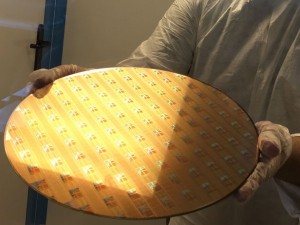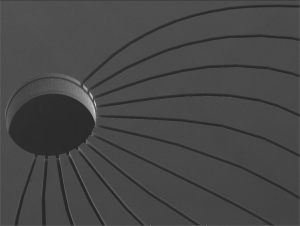
This 130-nm processed silicon wafer was produced during the AIDA-2020 project (at TSMC Foundry). These electronics will be used in the readout system of future detectors developed in the framework of AIDAInnova. Image: CERN
10 million euros. This will be the amount granted to members of the AIDAinnova project (advancement and innovation for Detectors at Accelerators programme) funded by the European Commission Horizon 2020 programme, under a special ‘Innovation Pilots’ call. As particle physics requires highly-specialised detection equipment, often on an industrial scale, the project will be strongly marked by the collaboration between industry and academic institutions.
AIDAinnova builds on the success of its predecessor projects AIDA and AIDA-2020, both of which boosted infrastructure at research labs for the development of new detector technologies. Coordinated by CERN, the successor project receives 10 million Euros for four years and features nine industrial companies, three research and technology organisations and 34 academic institutions in 15 countries. ‘Having companies directly involved in detector development is a novelty that aims at faster turnaround and more innovation both for research and industry,’ said Felix Sefkow (DESY, Germany), AIDAInnova coordinator, and scientific coordinator for the previous project AIDA-2020.
AIDAinnova will provide state-of-the-art upgrades to research infrastructures, such as test beams, in order to exploit the scientific potential of detector technologies. Among well-defined R&D work packages, scientists have opened the door to ‘greenfield’ projects. A call for tenders will be launched which will allow funding innovative and ‘off-axis’ projects.
There will be two levels of participation for industry. Companies may simply participate as associates of AIDAInnova member laboratories. Other companies – nine in total – signed to join as full members of the collaboration. They will use the EC funds to design and test detector parts or to employ dedicated staff. A new kind of collaboration with industry, more constraining but also with more benefits.
‘The nine industrial companies involved in AIDAInnova will benefit in many ways, first and foremost in terms of visibility,’ said Giovanni Calderini, AIDAInnova coordinator at CNRS/IN2P3, France. Being a full member of the project demonstrates a strong link with the scientific community and is also a heavy responsibility. ‘Collaborating with major institutions or laboratories such as CERN, IN2P3 or DESY to name a few, is a guarantee of quality for their future clients,’ said Calderini. ‘They may become later privileged partners for other scientific experiments, opening up new sectors and new markets.’ And the benefit is mutual. ‘In a collaboration, there is a deeper level of exchange. Sometimes this leads scientists to play an actual role within the company. Getting to know an industrial company in great detail is extremely valuable for us, the exchanges are sincere and transparent,’ concludes Calderini.

Detail of a micro-channel cooling system, developed at IN2P3 in France. This cooling technique will be at the heart of one of AIDAInnova work packages, in order to make it more uniform and efficient. It could be used with either ‘traditional’ liquids or biphasic liquids (like CO2). Image: Fundazione Bruno Kessler
AIDAInnova will cover a wide range of experiments from the second round of upgrades of the LHC detectors, at the mid of the high-luminosity phase (foreseen to be ready around 2030s) to CLIC, FCC and of course ILC detectors. Most work packages may contribute to any of these projects. For the ILC, one challenge will be to design mechanical structures and electronics as thin and light as possible so that incoming particles barely interact with them. Another crucial area of R&D will be the calorimetry, where scientists will try to increase detector granularity and time resolution for a more precise reconstruction of particle showers. Another promising technology for the ILC are monolithic sensors, where sensors and front end electronics are realised on a common silicon structure. ‘We’ve made a lot of progress in this area in the last years, and I’m convinced that these technologies will play a major role in the construction of the ILC detectors,’ says Calderini.
For all these technological challenges, collaboration with industry will be crucial, as the real difficulty will be to find a compromise between the most advanced technology to date and a reasonable cost for the scientific community. The AIDAInnova kick-off meeting, gathering all partners from academia to industry, will take place from 13 to 16 April 2021.

Recent Comments